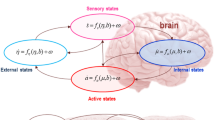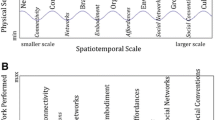Abstract
We develop a truism of commonsense psychology that perception and action constitute the boundaries of the mind. We do so however not on the basis of commonsense psychology, but by using the notion of a Markov blanket originally employed to describe the topological properties of causal networks. We employ the Markov blanket formalism to propose precise criteria for demarcating the boundaries of the mind that unlike other rival candidates for “marks of the cognitive” avoids begging the question in the extended mind debate. Our criteria imply that the boundary of the mind is nested and multiscale sometimes extending beyond the individual agent to incorporate items located in the environment. Chalmers has used commonsense psychology to develop what he sees as the most serious challenge to the view that minds sometimes extend into the world. He has argued that perception and action should be thought of as interfaces that separate minds from their surrounding environment. In a series of recent papers Hohwy has defended a similar claim using the Markov blanket formalism. We use the Markov blanket formalism to show how both of their objections to the extended mind fail.



Similar content being viewed by others
Notes
We explain the concept of the Markov blanket in Sect. 2. Pearl (1998) introduced the notion of a Markov blanket in the literature on Bayesian nets. It describes the set of variables for a node X in a network such that X is statistically independent of all other nodes in the network, and X’s behavior is predictable from knowing the variables comprising its Markov blanket.
We do not mean to claim that the folk psychological concepts of perception and action can be directly translated into and derived from talk of sensory and active states. We thank an anonymous reviewer for pressing us on this point. Our claim here, which we argue for in more detail in Sect. 2, is that the Markov blanket concept can be used to give formal precision to Chalmers’s appeal to common-sense. This is because sensory and active states just like perception and action serve as interfaces connecting mind and world. Chalmers shows how perception and action separates states internal to the mind from what is external to the mind. Our claim to be defended in more detail later is that sensory and active states perform a similar function in the Markov blanket formalism. Thus, we are arguing that the Markov blanket formulation can be used, in a similar fashion to the common-sense perception–action criterion, to demarcate the boundaries of the mind. We do not claim that the folk psychological notions of perception and action map directly onto the causal dynamics of cognition as described using the Markov blanket formalism. The question of how folk psychology relates to the causal dynamics of cognitive systems as described in scientific psychology is outside of the remit of our paper.
We dispute Hohwy’s claim that the boundary of the mind must always be centered on the brain. We will show how the processes of producing and maintaining a boundary for a living system take the form of Bayesian model optimisation, necessary for maintaining systemic organisation over time. Any system that maintains its organisation over time will at the same time sustain a boundary that separates the system from its environment. Such a boundary is necessary for ensuring that the system’s functional integrity persists over time and the system does not disintegrate, and disperse into its environment. We will argue that the cognitive system whose functional integrity is maintained over time can include environmental resources located external to the central nervous system.
We remain neutral on the question of whether the brain really encodes beliefs and carries out operations on content-bearing internal representations that approximate Bayesian inference. All that is important for our argument is that cognitive processes can be modelled as if the brain were engaging in these processes. There is a lively debate in the literature over whether the brain literally infers and entertains beliefs. See Bruineberg et al. (2016) and Anderson (2017) for deflationary arguments, and Hohwy (2013) and Kiefer (2017) for defense of a more robustly realist position. See Kirchhoff and Robertson (2018) and Ramstead et al. (2019) for critical discussion of the representationalist view of predictive processing. Dewhurst (2017) discusses the more general issue of how folk psychological states of belief and desire map onto a predictive processing cognitive architecture.
Bayesian belief optimisation is the process of updating beliefs when presented with new information in ways that best approximate Bayes’ rule. Bayes’ rule states that the posterior probability, p, of a state, Φ, given some data (sensory observations), s, is the same as the probability of s given Φ,multiplied by the prior probability of Φ, divided by the prior probability of s.
Hohwy draws his argument from the research of Karl Friston and his colleagues. See e.g. Friston (2013).
Hohwy is not alone in thinking that the Markov blanket that picks out the boundary of a system turns on explanatory interests. Clark writes: “The lesson… is that complex creatures are composed of layer upon layer of Markov blankets—which layers we choose to emphasise can only be fixed by our local explanatory interests and purposes.” (Clark 2017, p. 10).
See Kirchhoff et al. (2018) for a formal proof that unpacks how free energy bounds surprise.
Friston et al. (2012) express this idea well when they say that they understand “model” in the most inclusive sense, as combining interpretive disposition, morphology, and neural architecture, and as implying a highly tuned “fit” between the active, embodied organism and the embedding environment." (2012, p. 6).
Recall the notebook need not make such a constitutive contribution to active inference by forming a part of a predictive processing cognitive architecture. It is true that when Otto looks at his notebook there is no signal in the notebook that might be compared with the sensory signal from the eye to compute a prediction error. However we have been arguing that the notebook may nevertheless form a part of a cognitive system that approximates Bayesian inference. Predictive processing is one way of doing this but it may not be the only way, or so we have been arguing.
References
Adams, F., & Aizawa, A. (2008). The bounds of cognition. Hoboken: Wiley-Blackwell.
Allen, M., & Friston, K. (2018). From cognitivism to autopoiesis: Towards a computational framework for the embodied mind. Synthese. https://doi.org/10.1007/s11229-016-1288-5.
Anderson, M. (2017). Of Bayes and bullets: An embodied, situated, targeting-based account of predictive processing. In T. Metzinger & W. Wiese (Eds.), Philosophy and predictive processing (Vol. 3). MIND Group: Frankfurt am Main. https://doi.org/10.15502/9783958573055.
Bruineberg, J., Kiverstein, J., & Rietveld, E. (2016). The anticipating brain is not a scientist: The free-energy principle from an ecological-enactive perspective. Synthese. https://doi.org/10.1007/s11229-016-1239-1.
Chalmers, D. (2008). Foreword to supersizing the mind. Oxford: Oxford University Press.
Chalmers, D. (2019). Extended cognition and extended consciousness. In M. Colombo, L. Irvine, & M. Stapleton (Eds.), Andy Clark and his critics. Oxford: Oxford University Press.
Clark, A. (2008). Supersizing the mind. Oxford: Oxford University Press.
Clark, A. (2013). Whatever next? Predictive brains, situated agents, and the future of cognitive science. Behavioral and Brain Sciences, 36, 181–253.
Clark, A. (2016). Surfing uncertainty. Oxford: Oxford University Press.
Clark, A. (2017). How to knit your own Markov blanket: Resisting the second law with metamorphic minds. In T. Metzinger & W. Wiese (Eds.), Philosophy and predictive processing (Vol. 3). Frankfurt am Main: MIND Group. https://doi.org/10.15502/9783958573031.
Clark, A., & Chalmers, D. (1998). The extended mind. Analysis, 50, 7–19.
Colombetti, G., & Krueger, J. (2015). Scaffoldings of the affective mind. Philosophical Psychology, 28(8), 1157–1176.
Conant, R. C., & Ashby, W. R. (1970). Every good regular of a system must be a model of that system. International Journal of Systems Science, 1(2), 89–97.
Dewhurst, J. (2017). Folk psychology and the Bayesian brain. In T. Metzinger & W. Wiese (Eds.), Philosophy and predictive processing (Vol. 9). Frankfurt am Main: MIND Group. https://doi.org/10.15502/9783958573109.
Di Paolo, E. (2009). Extended life. Topoi, 28, 9–21.
Friston, K. J. (2011). What is optimal about motor control? Neuron, 72, 488–498.
Friston, K. (2013). Life as we know it. Journal of the Royal Society, Interface, 10, 20130475. https://doi.org/10.1098/rsif.2013.0475.
Friston, K. J., Levin, M., Sengupta, D., & Pezzulo, P. (2015). Knowing one’s place: A free energy approach to pattern regulation. The Journal of the Royal Society Interface, 12, 20141383. https://doi.org/10.1098/rsif.2014.1383.
Friston, K., Thornton, C., & Clark, A. (2012). Free-energy minimization and the dark-room problem. Frontiers in Psychology, 3(130), 1–7.
Hohwy, J. (2013). The predictive mind. Oxford: Oxford University Press.
Hohwy, J. (2015). The neural organ explains the mind. In T. Metzinger & J. M. Windt (Eds.), Open MIND (Vol. 19(T)). Frankfurt am Main: MIND Group. https://doi.org/10.15502/9783958570016.
Hohwy, J. (2016). The self-evidencing brain. Nous, 50(2), 259–285.
Hohwy, J. (2017). How to entrain your evil demon. In T. Metzinger & W. Wiese (Eds.), Philosophy and predictive processing (Vol. 3). Frankfurt am Main: MIND Group. https://doi.org/10.15502/9783958573048.
Japyassu, H. F., & Laland, K. (2017). Extended spider cognition. Animal Cognition, 20, 375–395.
Kiefer, A. (2017). Literal perceptual inference. In T. Metzinger & W. Wiese (Eds.), Philosophy and predictive processing (Vol. 17). Frankfurt am Main: MIND Group.
Kirchhoff, M. D., & Kiverstein, J. (2019). Extended consciousness and predictive processing: A third-wave view. Abingdon: Routldge.
Kirchhoff, M. D., Parr, T., Palacios, E., Friston, K. J., & Kiverstein, J. (2018). The Markov blankets of life: Active inference, autonomy and the free energy principle. The Journal of the Royal Society Interface, 15, 20170792. https://doi.org/10.1098/rsif.2017.0792.
Kirchhoff, M. D., & Robertson, I. (2018). Enactivism and predictive processing: A non- representational view. Philosophical Explorations, 21(2), 264–281.
Menary, R. (2007). Cognitive integration: Mind and cognition unbounded. Basingstoke: Palgrave Macmillan.
Menary, R. (2010). Cognitive integration and the extended mind. In R. Menary (Ed.), the extended mind (pp. 227–243). Cambridge, MA: The MIT Press.
Murphy, K. P. (2012). Machine learning: A probabilistic perspective. Cambridge, MA: The MIT Press.
Palacios, E., Razi, A., Parr, T., Kirchhoff, M. D., & Friston, K. (2017). Biological self-organisation and Markov blankets. BioRxiv. https://doi.org/10.1101/227181.
Pearl, J. (1998). Probabilistic reasoning in intelligent systems: Networks of plausible inference. San Francisco, CA: Morgan Kaufmann Publishers.
Ramstead, M., Kirchhoff, M. D., & Friston, K. (2019). A tale of two densities: Active inference is enactive inference. Adaptive Behavior, 1, 1. https://doi.org/10.1177/1059712319862774.
Rowlands, M. (2010). The new sciences of the mind. Cambridge, MA: The MIT Press.
Sprevak, M. (2009). Extended cognition and functionalism. The Journal of Philosophy, 106(9), 503–527.
Sprevak, M. (2010). Inference to the hypothesis of extended cognition. Studies in the History and Philosophy of Science Part A, 41(4), 353–362.
Acknowledgements
Kirchhoff was funded by an Australian Research Council Discovery Project “Minds in Skilled Performance” (DP170102987). Kiverstein was funded as part of the European Research Council ERC Starting Grant (679190) awarded to Erik Rietveld. We would also like to thank Jelle Bruineberg for helpful comments on a previous draft of this manuscript, as well as two anonymous reviewers for their help in improving the overall quality of this paper.
Author information
Authors and Affiliations
Corresponding author
Additional information
Publisher's Note
Springer Nature remains neutral with regard to jurisdictional claims in published maps and institutional affiliations.
Rights and permissions
About this article
Cite this article
Kirchhoff, M.D., Kiverstein, J. How to determine the boundaries of the mind: a Markov blanket proposal. Synthese 198, 4791–4810 (2021). https://doi.org/10.1007/s11229-019-02370-y
Received:
Accepted:
Published:
Issue Date:
DOI: https://doi.org/10.1007/s11229-019-02370-y




